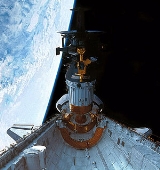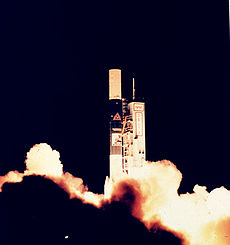
1989 in spaceflight
Encyclopedia

January
|-|colspan="8"|
February
|-|colspan="8"|
March
|-|colspan="8"|
April
|-|colspan="8"|
May
|-|colspan="8"|
June
|-|colspan="8"|
July
|-|colspan="8"|
August
|-|colspan="8"|
September
|-|colspan="8"|
October
|-|colspan="8"|
November
|-|colspan="8"|
December
|-|}
Deep-space rendezvous
| Date (GMT Greenwich Mean Time Greenwich Mean Time is a term originally referring to mean solar time at the Royal Observatory in Greenwich, London. It is arguably the same as Coordinated Universal Time and when this is viewed as a time zone the name Greenwich Mean Time is especially used by bodies connected with the United... ) |
Spacecraft | Event | Remarks |
|---|---|---|---|
| 23 January | Phobos 1 | Flyby of Mars Mars Mars is the fourth planet from the Sun in the Solar System. The planet is named after the Roman god of war, Mars. It is often described as the "Red Planet", as the iron oxide prevalent on its surface gives it a reddish appearance... |
Failed orbiter mission |
| 29 January | Phobos 2 | Areocentric orbit Areocentric orbit An areocentric orbit is an orbit around the planet Mars. The Moon, by similarity, is in a geocentric orbit around Earth.The areo- prefix is derived from the ancient Greek word Ares which is the personification of the planet Mars in Greek mythology.... injection |
|
| 27 March | Phobos 2 | Enters synchronous orbit of Phobos Phobos (moon) Phobos is the larger and closer of the two natural satellites of Mars. Both moons were discovered in 1877. With a mean radius of , Phobos is 7.24 times as massive as Deimos... |
|
| 25 August | Voyager 2 Voyager 2 The Voyager 2 spacecraft is a 722-kilogram space probe launched by NASA on August 20, 1977 to study the outer Solar System and eventually interstellar space... |
Flyby of Neptune Neptune Neptune is the eighth and farthest planet from the Sun in the Solar System. Named for the Roman god of the sea, it is the fourth-largest planet by diameter and the third largest by mass. Neptune is 17 times the mass of Earth and is slightly more massive than its near-twin Uranus, which is 15 times... |
Closest approach: 44800 kilometres (27,837.5 mi) |

